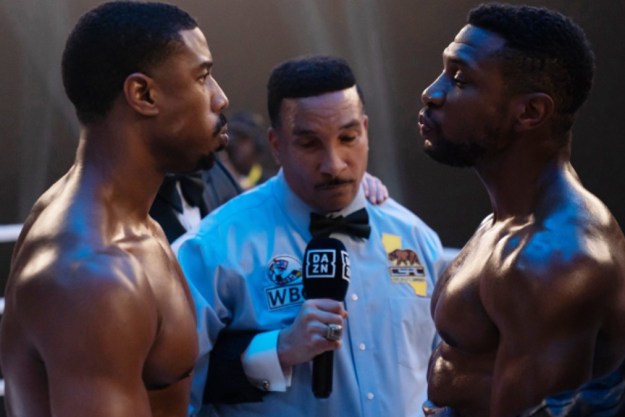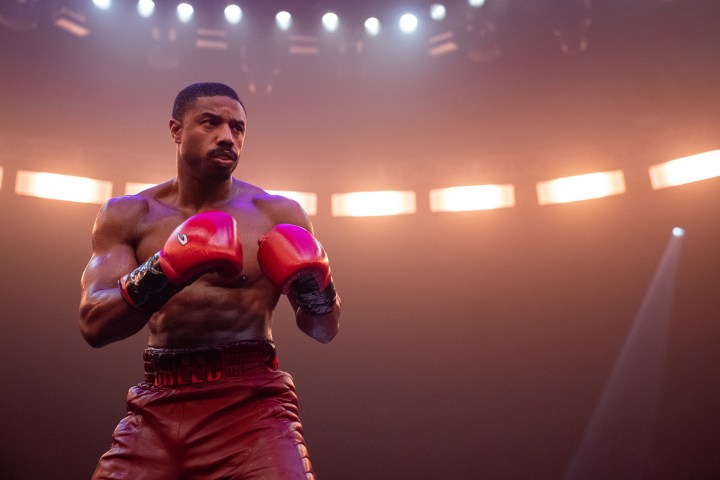
“Michael B. Jordan steps into the director's chair for the first time with Creed III, an imperfect blockbuster sequel that still manages to deliver all the thrills fans have come to expect from the boxing franchise.”
- Jonathan Majors' searing supporting performance
- Michael B. Jordan's passionate, if imperfect direction
- Kramer Morgenthau's warm, sun-soaked cinematography
- Keenan Coogler and Zach Baylin's uneven screenplay
- An overlong, occasionally languid second act
Creed III heralds the beginning of a new era for the Rocky spin-off franchise.
The film, which marks the directorial debut of franchise star Michael B. Jordan, is designed to exist free of the Rocky series’ shadow in a way that not even 2015’s Creed and 2018’s Creed III do. In order to achieve that separation, Jordan and screenwriters Keenan Coogler and Zach Baylin not only set the majority in Creed III in the city of Los Angeles, but they also cut Sylvester Stallone’s Rocky Balboa off from the franchise’s action. In Creed III, Stallone’s longtime screen hero is mentioned only once and his relationship with Jordan’s Adonis Creed is never directly acknowledged at any point throughout the film’s 116-minute runtime.
Behind the camera, Jordan attempts to introduce a new, anime-inspired visual style in Creed III, one that relies on slow-motion close-ups and moments of fantasy as opposed to the gritty but balletic style that writer-director Ryan Coogler established eight years ago. However, while Jordan’s attempt to redefine the conventional visual language of boxing movies is certainly admirable, it isn’t always totally effective. The same can be said for Creed III, which attempts to chart a new path for itself by cutting out certain aspects of its predecessors while sticking to the same formula.

Creed III is, much like Creed II, haunted by the past. The film’s opening sequence follows a young Adonis Creed (Alex Henderson) as he and his best friend, Damian “Dame” Anderson (Spence Duane Moore II), journey through a night that will forever change Dame’s life for the worse. Twenty years later, Creed III finds Jordan’s adult Adonis enjoying an early retirement with his deaf daughter, Amara (Mila Davis-Kent), and his music producer wife, Bianca (Tessa Thompson). In the aftermath of his boxing career, Adonis has begun to spend most of his days training new boxers at the LA gym he manages with Tony “Little Duke” Evers (Wood Harris).
Despite how far its protagonist has come, Creed III frequently returns to the images from its prologue, especially after Jordan’s adult Adonis finds himself shaken by the return of Dame, who is played as an adult by Ant-Man and the Wasp: Quantumania and Devotion star, Jonathan Majors. Having just finished an 18-year prison stint, Majors’ Dame, a once-promising boxer, asks Jordan’s Adonis for a shot at becoming champion. When Dame gets exactly that, his behavior both in and out of the ring sets him and Adonis on an inevitable path toward a brutal fight of their own.
Creed III, in other words, sticks to the same basic beats as so many of the boxing movies that have come before it. While Jordan, Coogler, and Baylin all attempt to inject new ideas into the Creed franchise’s existing themes of legacy and regret as well, there are moments when the film, nonetheless, feels stubbornly stuck to its own narrative tracks. The film’s pace suffers a bit as a result, especially during its second act, which is surprisingly meditative but too long. Fortunately, Creed III’s pace and energy always pick back up whenever Majors and Jordan are on-screen together.

The pair’s first scene, which takes place over a modest diner meal, is comprised mostly of close-ups that allow both Majors and Jordan to communicate their characters’ conflicting emotions in ways their words do not. Majors, in particular, shines in these moments. The actor, who has become one of Hollywood’s most in-demand talents within the span of just a few short years, is able to use his eyes and body language to communicate the shades of anger, sorrow, loneliness, and desperation that are always at war within his character. When Dame tells Adonis that “the clock is ticking” for him, it’s the small quiver in Majors’ voice that sells it as both a statement of fact and a desperate plea.
Opposite him, Jordan is as capable as ever at portraying Adonis’ inability to truly open up about his emotions. In Creed III, the character’s unwillingness to be vulnerable becomes a point of contention between him and Bianca after their daughter gets into a fight at school. Bianca rightly sees Amara’s instinct to fight rather than process her emotions as something that needs to be addressed, but Adonis argues that sometimes “a punch in the face” really is the only solution to a problem. The film’s attempts to grapple with Adonis’ reliance on violence add an interesting shade of modernity to Creed III’s traditional structure, but the movie doesn’t have the time to truly explore the impact that Adonis’ way of life has on both his daughter and wife.

The film’s argument that violence isn’t always the answer is also undercut by the fact that its climax inevitably revolves around Adonis and Dame punching the living daylights out of each other. Jordan doesn’t shy away from just how emotionally destructive Dame and Adonis’ boxing match is, though. The director inserts close-ups throughout the fight that, thanks to his and Majors’ emotional range, effectively communicate the feelings of shame, rage, and helplessness that both of their characters are forced to confront every round.
It’s in Creed III’s climactic match that Jordan also leans all the way into his anime influences. At times, the film not only reimagines Adonis and Dame’s fight as taking place in an empty, fog-covered arena, but in one audacious creative swing, Jordan also uses visual effects to turn the ring into a literal prison cell. Unfortunately, while the boldness of Jordan’s choices is to be admired, not all of his visual swings truly connect. The director is ultimately unable to recapture the same wide-angle gracefulness that Ryan Coogler skillfully brought to Creed. Instead, the new film’s fight sequences rely on far more cuts and insert shots, which do occasionally dull their impact.
Jordan’s decision to visualize the split-second moments when boxers catch the gaps in their opponents’ defenses, however, feels like the kind of inspired directorial choice that will likely be copied by other directors in the years to come. Even in the moments of visual invention that don’t totally work, there’s also a passion behind Jordan’s direction that fills Creed III with an energy that is usually absent by the time most franchises reach their third installment. Together, Jordan and Majors ensure that Creed III offers audiences an enjoyable — if not necessarily knockout — time at the theater.
Creed III is now playing in theaters.
Editors' Recommendations
- Creed 3’s ending explained
- Creed III final trailer teases explosive fight between Adonis and Damian
- Michael B. Jordan faces toughest challenge yet in first trailer for Creed III
- Glass Onion review: a deviously intricate Knives Out sequel
- Nope review: Jordan Peele’s intelligent sci-fi horror delivers




